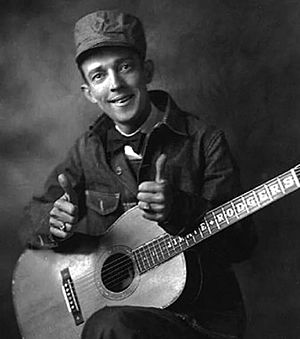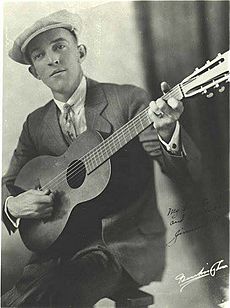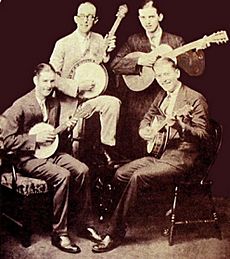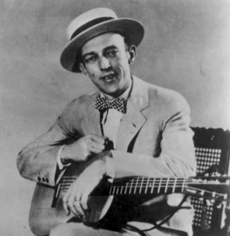Jimmie Rodgers facts for kids
Quick facts for kids
Jimmie Rodgers
|
|
|---|---|

Rodgers in 1931
|
|
| Background information | |
| Birth name | James Charles Rodgers |
| Born | September 8, 1897 Meridian, Mississippi, U.S. |
| Died | May 26, 1933 (aged 35) New York City |
| Genres | |
| Occupation(s) |
|
| Instruments |
|
| Years active | 1910–1933 |
| Labels | Victor |
James Charles Rodgers (born September 8, 1897 – died May 26, 1933) was an American singer, songwriter, and musician. He became very popular in the late 1920s. Many people call him "the Father of Country Music". He is famous for his special way of yodeling with a rhythm.
Rodgers was also known as "The Singing Brakeman" and "America's Blue Yodeler". Many artists have said he inspired their music. He has been honored in several music halls of fame.
Jimmie grew up in Meridian, Mississippi. His dad worked for the railroad. Because of his dad's job or Jimmie's own health, his family moved around a lot. As a teenager, he loved watching different vaudeville shows, which are like variety shows. When he was 13, Jimmie won a local singing contest. He then traveled through the Southern United States with a medicine show, performing.
After his dad brought him home, Jimmie left school. He started working for the railroad, first as a waterboy, then as a brakeman. While working on the railroad, he learned more about music. He was inspired by the "gandy dancers" (railroad workers) and their blues songs. In 1924, Jimmie was diagnosed with tuberculosis, a lung illness. By 1927, his health made it hard to work on the railroad. He decided to focus on his music full-time.
In 1927, Rodgers joined a band called the Tenneva Ramblers. They played at a radio station. After they lost that job, they performed in the Blue Ridge Mountains. There, Jimmie learned that a record company engineer, Ralph Peer from the Victor Talking Machine Company, was looking for new artists in Bristol, Tennessee. These were called "field recordings." During these famous "Bristol sessions," Jimmie recorded by himself. His band had left him after an argument.
Later, Jimmie insisted on another recording session in Camden, New Jersey. This session produced the hit song "Blue Yodel No. 1 (T for Texas)". The song became a huge success. It made Jimmie famous across the country and started his recording career. He recorded over 100 songs with Victor.
Contents
Early Life and Railroad Work
Jimmie Rodgers' family came to the United States from Ireland before the American revolution. They lived near the Appalachian Mountains. Later, they moved to the Southern and Western parts of the U.S. Jimmie's father, Aaron, worked for the Mobile and Ohio Railroad. He became a foreman and married Eliza Bozeman in 1884. The family often lived in railroad work camps.
Jimmie Rodgers was born on September 8, 1897. His birthplace is often listed as Meridian, Mississippi. But Jimmie once signed a paper saying he was born in Geiger, Alabama. His mother, Eliza, got sick and passed away in 1903 when Jimmie was six. This was a very sad time for him.
Jimmie and his brother Talmage went to live with relatives. Jimmie didn't go to school very often, especially after his mother died. Later, when his dad remarried and they moved to Meridian, Jimmie went to high school. But he often skipped school to go to local theaters. He loved watching vaudeville shows and movies. This made him interested in becoming an entertainer.
In 1906, Jimmie lived with his aunt and older brother. He started going to school more regularly. He learned a lot during this time. When he returned to Meridian in 1911, he spent time at his uncle's barbershop. He even organized a small carnival that traveled to nearby towns. Jimmie also won a singing contest at the Elite Theater. After this success, he performed with a medicine show for a few weeks.
At 13, Jimmie started working for a tailor. A few months later, his dad brought him back to Meridian. Instead of going back to school, Jimmie followed his father to learn about railroad work. He started as a waterboy for the "gandy dancer" crews, who taught him about their blues music. He then became a baggage handler and a brakeman. He moved around a lot, working on railroad lines from Mississippi to Texas.
In 1917, Jimmie married Stella Kelly. They later separated. He then married Carrie Williamson in 1920. They had two daughters, Anita and June. Sadly, June passed away when she was very young.
Music Career and Fame
In 1924, Jimmie Rodgers was diagnosed with tuberculosis. This illness made it hard for him to do his railroad job. He moved to Arizona and then to Asheville, North Carolina, hoping the dry air would help. As he worked less on the railroad, he started performing music more.
Jimmie formed a jazz-style band. They played popular songs. In 1927, he left the railroad for good. In Asheville, he met the Tenneva Ramblers, a mountain music band. Jimmie convinced them to join him as "The Jimmie Rodgers Entertainers." They got an unpaid spot at a radio station, WWNC.
After the band was fired from the radio show, they found work at a resort. There, Jimmie heard about Ralph Peer's upcoming recordings in Bristol, Tennessee. Jimmie set up an appointment for his band to record on August 4, 1927. But before the recording, the band argued with Jimmie about the name for the record. The Tenneva Ramblers left Jimmie.
Jimmie convinced Peer to record him alone with his guitar. Peer liked Jimmie's bluesy style. This first session produced "The Soldier's Sweetheart" and "Sleep, Baby, Sleep." These songs sold well. Peer then asked Jimmie to record more original songs.
Jimmie traveled to New York City and boldly asked Peer for another session. On November 30, 1927, in Camden, New Jersey, Jimmie recorded a new song he had been working on. It featured his unique yodeling. Peer called it "Blue Yodel."
"Blue Yodel" became a huge hit in 1928. It was the first of many "blue yodel" songs. Jimmie's yodeling style was special. It might have come from traditional mountain songs, railroad workers, or vaudeville shows. "Blue Yodel No. 1" sold over a million copies during his lifetime. Soon, Jimmie was known as "America's Blue Yodeler."
Jimmie's sister-in-law, Elsie McWilliams, helped him write many of his songs, including most of his Blue Yodels. He also worked with other songwriters. His songs like "In the Jailhouse Now" and "Waiting for a Train" also became very popular. "Waiting for a Train" became his second best-selling song.
In February 1929, Jimmie's health got worse. Doctors found that he had serious pulmonary tuberculosis affecting his lungs. Despite this, he continued to tour. He eventually settled in Kerrville, Texas, because the dry air and mild weather were thought to help with tuberculosis. He built a home there and called it "Blue Yodeler's Paradise." His stage clothes changed from railroad worker outfits to cowboy hats and Western clothes.
Even during the Great Depression, Jimmie's records continued to sell well. He made more recordings, including "Blue Yodel no. 8, Mule Skinner Blues" and "Blue Yodel No. 9 (Standin' on the Corner)" with Louis Armstrong. He also recorded "T.B. Blues" about his illness.
In 1931, Jimmie recorded with the Carter Family. His health continued to decline, and he had to sell his home. He still made radio appearances and recorded new songs.
Declining Health and Passing
As Jimmie's health worsened, he cut back on his touring. Many concerts were shortened or canceled because he was too sick. He continued to record, even resting between takes in the studio. In early 1932, he collapsed during a show and needed an oxygen tent.
In May 1933, Jimmie traveled to New York City for another recording session. He recorded several songs, resting on a cot between takes. The next day, he felt better and visited Coney Island. But when he returned to his hotel, he became very ill. He suffered a severe cough and passed away soon after.
Jimmie Rodgers' body was taken back to Meridian, Mississippi, by train. He was buried at Oak Grove Cemetery. Jimmie's music helped the Victor Talking Machine Company sell many records, even during the Great Depression. At the time of his death, his sales made up 10% of the company's total.
Style and Image
Jimmie Rodgers never said exactly why he started playing the guitar. He knew only a few chords but played with a special flatpicking style. His music blended classic English and Celtic storytelling with strong influences from black blues music.
His songs included different types: old sentimental songs, funny vaudeville songs, blues songs, traditional folk songs, and country songs. He even worked with jazz and Hawaiian musicians.
Jimmie's yodeling was unique. Unlike traditional mountain yodels, his had a different rhythm. He learned to stretch or shorten words to fit his songs. He often carried a banjo or guitar with him while working on the railroad. In his live shows and recordings, he would speak between verses or make train whistle sounds with his throat.
Early in his career, Jimmie wore a bowler hat and suit, like vaudeville performers. When he became "The Singing Brakeman," he added railroad worker clothes to his stage outfits. After moving to Texas, he started wearing cowboy hats and Western clothes, like the popular "singing cowboys" in movies. He would choose his clothes based on his audience.
Personal Life
Jimmie Rodgers married Carrie Williamson in 1920. They had a daughter named Anita. Jimmie was a Freemason, joining the group in Meridian in 1920. He also joined the Benevolent and Protective Order of Elks in 1930. In 1931, he became a "Master Mason."
In 1931, Jimmie was made an honorary Texas Ranger in Austin, Texas. To celebrate, he later released a song called "The Yodeling Ranger."
Legacy
Influence
Jimmie Rodgers is known as the Father of Country Music. He was one of the first people inducted into the Country Music Hall of Fame in 1961. The Hall of Fame says he brought a "distinctive, colorful personality" and a "rousing vocal style" to country music. He helped define what a country music star could be.
The Rock and Roll Hall of Fame also inducted Rodgers in 1986 as an early influence. They said his mix of blues, Appalachian ballads, and spirituals helped create the foundation for rock and roll. He influenced artists like Bob Dylan and Lynyrd Skynyrd. The Blues Hall of Fame noted that his blues songs helped make the music popular with white audiences.
Rodgers was also the first artist inducted into the Songwriters Hall of Fame in 1970. They said his music blended "hillbilly, gospel, blues, jazz, pop and mountain folk music" into timeless American songs. He is also in the Nashville Songwriters Hall of Fame, the Alabama Music Hall of Fame, and the Blue Ridge Music Hall of Fame.
Rolling Stone magazine placed Rodgers high on their lists of greatest country artists and greatest singers. Allmusic called him "the first nationally known star of country music." They said he made country music a popular and successful style.
Many country singers were influenced by Jimmie Rodgers. Gene Autry and Jimmie Davis recorded many of his songs, including yodeling ones. Hank Snow learned to play guitar and sing by imitating Rodgers. Ernest Tubb considered Rodgers his biggest influence. Jimmie's widow, Carrie Rodgers, even gave Ernest Tubb Jimmie's guitar as a gift.
Other famous artists influenced by Rodgers include Robert Johnson, Johnny Cash, Willie Nelson, Merle Haggard, Bob Dylan, George Harrison, and Alison Krauss. Jimmie's film The Singing Brakeman is thought to be one of the first music videos.
Jimmie Rodgers' music was also popular in South Africa. People there, especially the Zulu people, loved his records. Local singers even recorded their own versions of his blue yodels in the Zulu language. In Zimbabwe, acoustic guitarists in the 1940s were influenced by his style. English missionaries brought Rodgers' recordings to Kenya, where the Kipsigis people sang about him in a traditional song called "Chemirocha III."
Tributes
In 1935, the Delmore Brothers and Uncle Dave Macon played a tribute song called "Blue Railroad Train" to Jimmie. That same year, Jimmie's widow, Carrie Rodgers, published a book about him called My Husband, Jimmie Rodgers.
The first Jimmie Rodgers Memorial Festival was held in Meridian in 1953. Many country singers and Jimmie's family attended. The festival became a regular event starting in 1972. Over 30,000 people came to the first event. A monument to Rodgers was unveiled, along with a train as a memorial to railroad workers.
In 1978, the United States Postal Service released a stamp honoring Rodgers. It was the first in their Performing Arts Series. The 1982 movie Honkytonk Man, starring Clint Eastwood, was loosely based on Jimmie's life.
In 1997, Bob Dylan put together a tribute album called The Songs of Jimmie Rodgers, A Tribute. It featured famous artists like Bono, Jerry Garcia, and Willie Nelson covering Rodgers' songs. In 2004, Steve Forbert's tribute album Any Old Time was nominated for a Grammy Award.
In 2007, Rodgers was honored with a marker on the Mississippi Blues Trail in Meridian. In 2010, a marker on the Mississippi Country Music Trail was placed near his grave. The song "Jimmie Rodgers' Dream" by Elton John and Leon Russell (2010) also paid tribute to him. In 2013, a historical marker was placed in Asheville, North Carolina, where he once lived.
See also
 In Spanish: Jimmie Rodgers para niños
In Spanish: Jimmie Rodgers para niños
- Jimmie Rodgers discography




